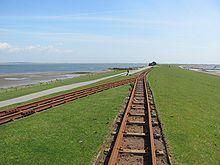A railway zig zag, also called a switchback, is a method of climbing steep gradients with minimal need for tunnels and heavy earthworks. For a short distance (corresponding to the middle leg of the letter "Z"), the direction of travel is reversed, before the original direction is resumed.
A location on railways constructed by using a zig-zag alignment at which trains have to reverse direction in order to continue is a reversing station.
Zig zags tend to be cheaper to construct because the grades required are discontinuous. Civil engineers can generally find a series of shorter segments going back and forth up the side of a hill more easily and with less grading than they can a continuous grade which has to contend with the larger scale geography of the hills to be surmounted.
Zig zags suffer from a number of limitations:
The length of a train is limited to what will fit on the shortest stub track in the zig zag. The Lithgow Zig Zag stub was extended at great cost in 1908, only to be completely deviated in 1910.Reversing a locomotive-hauled train without running an engine around to the rear of the train is hazardous. Top and tail or push pull operation with engines at the rear of the train helps.The process is slow due to the need to stop the train after each segment and reverse the switch.It is by nature a single track configuration.If wagons in a freight train are marshalled poorly, with a light vehicle located between heavy ones (particularly with buffer couplings), the move on the middle road of a zig zag can cause derailment of the light wagon.
ArgentinaTren a las Nubes (1921)AustraliaLithgow Zig Zag (rail line) (1869-1910) (see Zig Zag Railway) (preservation society) (1975-))Out of use:Thornleigh Zig ZagYarraglen (dismantled)Kalamunda Zig Zag – Two reversalsLapstone Zig Zag – Two reversals (1865)Mundaring Weir Branch RailwayYarloop, Western Australia (dismantled)Lake Margaret Tram 610 mm (2 ft)Burma (also known as Myanmar)Passenger line between Thazi and Kalaw, with four switchbacks; still in usePassenger line between Mandalay and LashioChinaQinglongqiao on the Jingbao RailwayChilePisagua – Three reversals; long out of use but earthworks easy to traceDenmarkLemvig – Small side track from the harbor to the railway station, used only on special occasions. In reality only half a 'Z' as only one reversal is needed.EcuadorSibambe on the Quito-Guayaquil line (cf. Empresa de Ferrocarriles Ecuatorianos)FranceFroissy Dompierre Light RailwayGermanyIn use:Rauenstein (Hinterland Railway)Lauscha (Sonneberg – Probstzella railway)Ernstthal am Rennsteig: created by close of the Ernstthal–Probstzella railwayLüttmoorsiel-Nordstrandischmoor island railwayRennsteig (Rennsteig Railway, Ilmenau – Themar)Michaelstein (Rübeland Railway)Wurzbach (Saalfeld – Blankenstein railway)Altenkirchen station, Limburg–Altenkirchen railwayout of useSchillingsfürst (dismantled)Lenzkirch in the Black Forest (dismantled)Elm (replaced in 1914 by Distelrasen Tunnel, but the structure is conserved within the Frankfurt-Fulda and Fulda-Gemünden railways and the connecting curve between the stations at Elm and SchlüchternSteinhelle-Medebach railway (double zig zag)Mainspitze station in Frankfurt am Main, used from 1846 - 1848 to reach the provisional Frankfurt terminal of the Main-Neckar Railway (dismantled)HungaryNagybörzsönyi Erdei Vasút has a simple zig zag at the middle of the railway line between Kisirtás and Tolmács-hegy stations, with a loop in the middle of the Z shape, narrow gaugeIndiaDarjeeling Himalayan Railway has six full zig zags, most are from the construction of the current railway but one was added in the 1940s and at least one other was used temporarily following storm damage, narrow gaugeItalySaline-Volterra (dismantled in 1958)JapanHakone Tozan Line has three zig zags, namely at Deyama S.B., Ōhiradai Station, Kami-Ōhidradai S.B.Hōhi Main Line at Tateno StationKisuki Line at Izumo-Sakane StationHisatsu Line at Okoba and Masaki stationsTateyama Sabō Erosion Control Works Service Train, the work train for an erosion control construction, is not open to general public, but deserves a mention for its 38 zig zags, 18 of them in a row.Niyama Station on Hakodate Main Line (see #Wartime type switchback)South KoreaYeongdong Line, between Heungjeon station and Nahanjeong station. This section closed in 2012 and replaced by Solan tunnel .PakistanKhyber PassPeruSeven full Zigzags and one single reverse on the Central Railway of PeruPeruRail between Cuzco to Machu Picchu – Five switchbacksSlovakiaHistorical Logging Switchback Railway in VychylovkaSwedenLövsjöväxeln (Lövsjö points) on Hällefors-Fredriksbergs Järnvägar (1875-1940)TaiwanAlishan Forest RailwayUnited StatesHagans Switchback in VirginiaEight switchbacks at Cascade on GN – Replaced by tunnel which was in turn replaced by a longer tunnelCass Scenic Railroad, West Virginia – Two switchbacks with 11% grade between, still in useConfusion Hill Mountain Train Ride, Piercy, California – Several switchbacks in useIndustrial switchback, Montage Mountain Road, Scranton, Pennsylvania – Still in useMount Hood Railroad, Hood River, Oregon – One switchback, still in useRoaring Camp and Big Trees Narrow Gauge Railroad, Felton, California – One switchback, still in useShasta Sunset Dinner Train, McCloud, California – One switchback, "Signal Butte Switchback", in use
